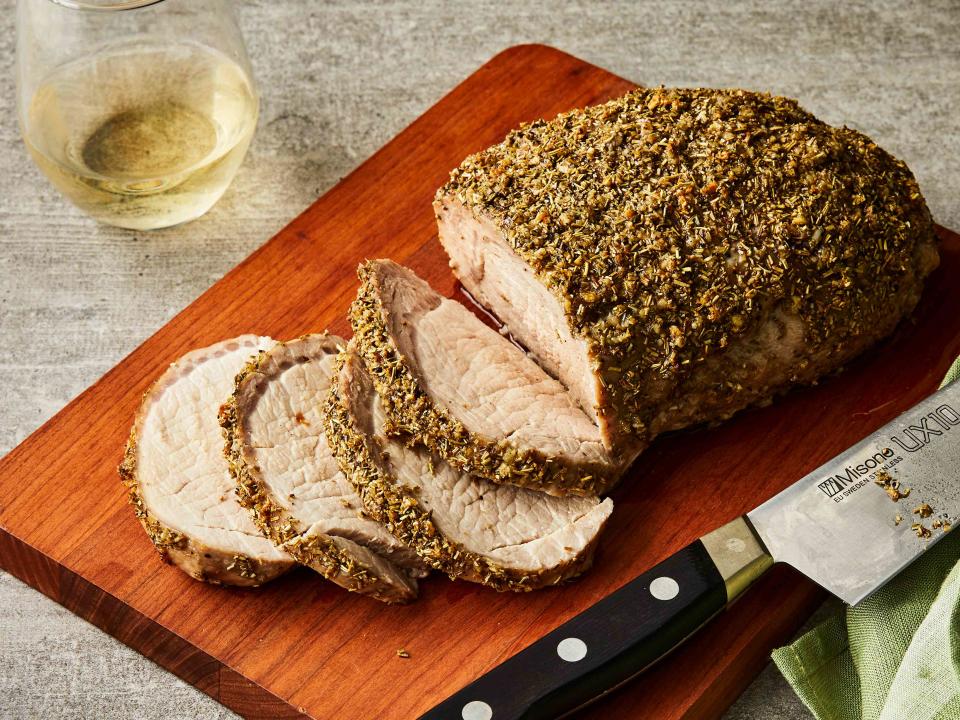Pork Loin vs. Pork Shoulder: What's the Difference and Which Should You Use?
Pondering cuts of pork? Get the answers here.

DOTDASH MEREDITH FOOD STUDIOS
Cuts of meat and their names are some of the most confusing things for the home cook to contemplate in a store, and pork is no different.
Two popular choices are pork loin and pork shoulder, as they're perfect for a multitude of preparations including roasting, braising, slow-cooking, and sausage-making. Pork loin and pork shoulder are both cuts from the shoulder blade area of the animal and they're similar in size and shape.
With all this in common, it can be quite difficult to decide, but there are some distinct differences that will affect the flavor, tenderness, cooking time of what you're making — not to mention your wallet.
Related: Bone-In vs. Boneless Pork Chops: Which Should I Buy?
What Is Pork Loin?
Not to be confused with tenderloin, the pig's loin is a lean cut meat of near the animal's backbone. In addition to being lower in fat than many other cuts of pork, the loin has a delightfully tender texture. It's available in multiple sizes, from large roasts to individual cuts and bone-in to boneless.
Pork loin is friendly to the grocery budget and will be beloved by anyone who loves a good pork chop or is partial to pork tenderloin. Its larger size might not be the first thing you think of when you are pondering a weeknight dinner, it cooks up quite easily in the oven or on the grill. (It's scrumptious seared off in a pan and then roasted.) Pork loin makes an excellent canvas for all manners of sauces, glazes, and rubs.
What Is Pork Shoulder?
Pork shoulder likes to be especially elusive, also going by the name pork butt or Boston butt, yet cut from the shoulder of the pig. Its use in everything from stews to soups to carnitas to pulled pork makes it one of the most purchased cuts.
Related: Chef John's Best Pork Shoulder Recipes
The shoulder is fairly tough in nature, with its connective tissues and larger amount of fat (about 16-30% fat compared to the 9-14% of pork loin). With that in mind, slow cooking is the name of the game for pork shoulder. Once the fat and tissues break down, the meat is melt-in-your-mouth tender and incredibly flavorful.
Pork shoulder is even more kind to the budget than pork loin and more adaptable to a variety of recipes (not to mention forgiving). You'll find it sold bone-in or boneless, or labeled as picnic shoulder, with the fat cap and skin still attached.
Differences Between Pork Loin and Pork Shoulder
Once you get past all the similarities, there are roughly 5 differences between the two: location, cooking method and time, price, flavor and texture, and fat content.
Location
Pork loin is a long, cylindrical cut from the pig's back, whereas pork shoulder comes from the front of the pig.
Cooking Method and Time
While the loin can be cooked either at high heat or at low heat in a pan (to keep this lean cut from drying out) and turned out in a pinch, the shoulder needs low and slow approach for best results.
Related: What Is Barbacoa and How Do You Make It?
Price
Though either cut is an economical choice for your kitchen, pork loin tends to be more expensive due to its leaner composition.
Flavor and Texture
Pork loin holds its own when seasonings are kept simple and is the most tender of the two in its natural state. The shoulder, on the other hand has a bolder flavor and can stand up to richer, bolder sauces. Once cooked, the shoulder is luxuriously rich and tender.
Fat Content
Pork loin is lean with very little marbling. The shoulder, on the other hand, can be quite fatty, requiring a more laborious cook time, but making up for it with robust flavor.
Can you Substitute One for the Other?
Flavor-wise, the answer to this is yes, you can. If the dish you're looking to achieve is one cooked low and slow, by all means, but I wouldn't swap a shoulder for a loin in a pan-roasted or quick-cooking dish; you'll end up in a tough spot, indeed.
What's Better for Pulled Pork?
Related: The Secret to Making Pulled Pork Just Like Grandma
In truth, either cut can produce pulled pork. Pork shoulder tends to be the top choice, though, as its fat imparts a deeper, heartier flavor.
Neither loin nor shoulder is a better cut — it's all about what you're looking to achieve. But no matter what pork is your pleasure, season your prize generously to ensure maximum enjoyment and be sure to cook it to a minimum of 145 degrees F.

